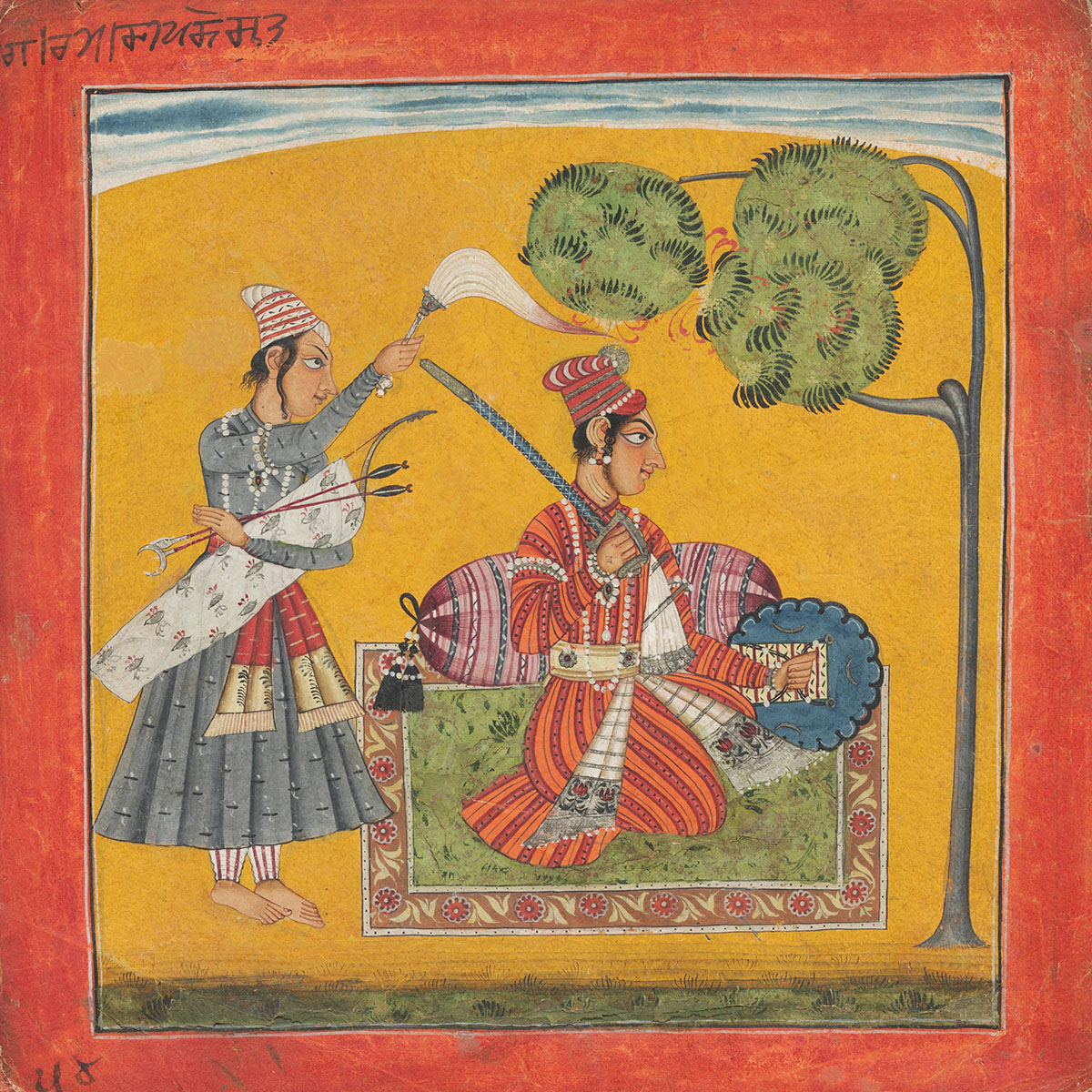Comprising a set of miniature paintings, a ragamala depicts the visualised forms of six ragas, or melodies, of Indian classical music as well as their derivatives or raginis. The term itself literally means “garland of ragas,” referring to both the musical and pictorial aspects of ragas and raginis.
Ragamala paintings began to be made in the late fifteenth century, while ragas themselves have been in use in Indian classical music since the fifth century CE. The most prominent patrons of these paintings were the Rajput courts in present-day Rajasthan, for whom ragamala sets became an area of patronage within miniature painting. Ragamala paintings were historically made as a set of thirty-six or more folios, each accompanied by a Sanskrit verse or a mention of the associated raga.
A raga, also known as a raag or ragam, is a specific series of notes arranged in fixed ascending and descending orders, with a prescribed degree of stress (called chalan) on each note. Each raga is meant to evoke a particular mood or atmosphere, through which its musical framework may be applied to other art forms, including the visual arts. While there are hundreds of ragas, the six ragas traditionally depicted in ragamala paintings are: bhairava, shri, malkauns, deepak, megh malhar and hindol. Within a ragmala, ragas typically represent seasons, weather changes or times of day. Further, each raga is personified as a human man, who is then paired with consorts (raginis), daughters (ragaputris) and sons (ragaputras), all of which are further derivations of the ragas found in Indian classical music. While the list of ragas and raginis in most ragamala paintings remains standard, variations and substitutions often occur in particular sets as a result of artistic liberty or the preferences of the patron.
While the ragas were meant to represent the essence of seasonal and temporal change, the raginis were characters or nayikas whose individual stories added a human element to those seasons or times of day. Though ragas and raginis were not necessarily depicted in the same painting, the raga’s presence was always a part of a ragini painting in some form. For example, the ragini Bhairavi is depicted as a lone devotee of Shiva, at whose shrine she offers freshly plucked flowers, and the ragini Lalita is shown as a woman asleep in her bed while her lover departs, looking at her over his shoulder. Both these images, despite their many apparent differences, are meant to evoke the early morning bhairava raga, played in all seasons.
The relationship between the raga and ragini is particularly important in ragamala paintings as a site for the exploration for romantic, erotic and devotional love. The increased patronage towards manuscript painting across the subcontinent in the sixteenth century coincided with the rise of the Bhakti movement. This resulted, among other things, in the depiction of love and divine devotion as nearly interchangeable concepts in Rajput painting. The earliest surviving example of ragamala painting is a set of ten images showing five ragas and five raginis, painted in the margins of a now lost manuscript made in 1475. These ragas are clearly divine figures, at least two of which can be identified as Shiva and Vishnu. However, the next instances of ragamala painting a century later show scenes of ragas and raginis in human form, particularly ones where raginis are longing for an absent lover. Such ragamala paintings were seen as a set of images describing the love between the human and the divine, evoking moods that could be playful, mournful, serene or secretive. This conflation of god with mortal and love with devotion, set against a lush, natural backdrop, was a result of emerging ideas of worship inspired by the Bhakti movement.
Apart from Rajput kingdoms, ragamala paintings were also made for the Deccan courts of Ahmadnagar and Bijapur in the late sixteenth century, a period in which illustrated manuscripts received generous patronage in the region. Scholars speculate that Hindu feudal lords in the northern Deccan may also have commissioned a few ragamala sets around this time. By 1650, however, few ragamala sets were being made in the Deccan and many of these were supported by the patronage of Rajput courts, resulting in a hybrid style that catered to the tastes of specific Rajasthani courts while retaining the hand of Deccani artisans. In some cases, the facial features, costumes and accessories of ragas and raginis would appear overtly Mughal, despite not being made for the Mughal court. These may have been attempts by the vassal kingdoms in Rajasthan to gain favour with the Mughals by emulating their style or even painting these figures in the likeness of the Mughal royal family.
From the late nineteenth century onwards, manuscript painting as a court art suffered a decline and, today, most ragamala sets have been dispersed across the world. Some examples can be found in the collections of the Metropolitan Museum of Art, New York, USA; the British Museum, London, UK; and the Salar Jung Museum, Hyderabad, to name a few.







